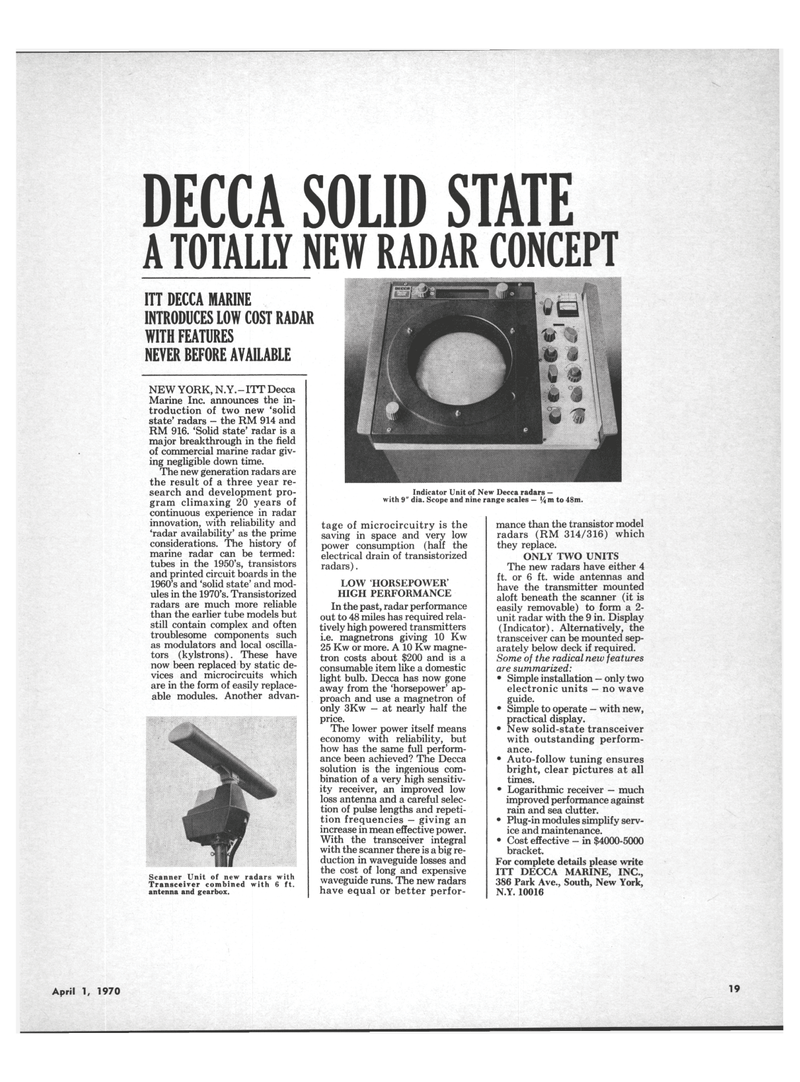
Page 17: of Maritime Reporter Magazine (April 1970)
Read this page in Pdf, Flash or Html5 edition of April 1970 Maritime Reporter Magazine
DECCA SOLID STATE A TOTALLY NEW RADAR CONCEPT
ITT DECCA MARINE
INTRODUCES LOW COST RADAR
WITH FEATURES
NEVER BEFORE AVAILABLE
NEW YORK, N.Y.-ITT Decca
Marine Inc. announces the in- troduction of two new 'solid state' radars - the RM 914 and
RM 916. 'Solid state' radar is a major breakthrough in the field of commercial marine radar giv- ing negligible down time.
The new generation radars are the result of a three year re- search and development pro- gram climaxing 20 years of continuous experience in radar innovation, with reliability and 'radar availability' as the prime considerations. The history of marine radar can be termed: tubes in the 1950's, transistors and printed circuit boards in the 1960's and 'solid state' and mod- ules in the 1970's. Transistorized radars are much more reliable than the earlier tube models but still contain complex and often troublesome components such as modulators and local oscilla- tors (kylstrons). These have now been replaced by static de- vices and microcircuits which are in the form of easily replace- able modules. Another advan-
Scanner Unit of new radars with
Transceiver combined with 6 ft. antenna and gearbox.
Indicator Unit of New Decca radars — with 9" dia. Scope and nine range scales — (4 m to 48m. tage of microcircuitry is the saving in space and very low power consumption (half the electrical drain of transistorized radars).
LOW HORSEPOWER'
HIGH PERFORMANCE
In the past, radar performance out to 48 miles has required rela- tively high powered transmitters i.e. magnetrons giving 10 Kw 25 Kw or more. A 10 Kw magne- tron costs about $200 and is a consumable item like a domestic light bulb. Decca has now gone away from the 'horsepower' ap- proach and use a magnetron of only 3Kw - at nearly half the price.
The lower power itself means economy with reliability, but how has the same full perform- ance been achieved? The Decca solution is the ingenious com- bination of a very high sensitiv- ity receiver, an improved low loss antenna and a careful selec- tion of pulse lengths and repeti- tion frequencies - giving an increase in mean effective power.
With the transceiver integral with the scanner there is a big re- duction in waveguide losses and the cost of long and expensive waveguide runs. The new radars have equal or better perfor- mance than the transistor model radars (RM 314/316) which they replace.
ONLY TWO UNITS
The new radars have either 4 ft. or 6 ft. wide antennas and have the transmitter mounted aloft beneath the scanner (it is easily removable) to form a 2- unit radar with the 9 in. Display (Indicator). Alternatively, the transceiver can be mounted sep- arately below deck if required.
Some of the radical new features are summarized: • Simple installation — only two electronic units — no wave guide. • Simple to operate — with new, practical display. • New solid-state transceiver with outstanding perform- ance. • Auto-follow tuning ensures bright, clear pictures at all times. • Logarithmic receiver — much improved performance against rain and sea clutter. • Plug-in modules simplify serv- ice and maintenance. • Cost effective - in $4000-5000 bracket.
For complete details please write
ITT DECCA MARINE, INC., 386 Park Ave., South, New York,
N.Y.10016
April 1, 1970 19

 16
16

 18
18
